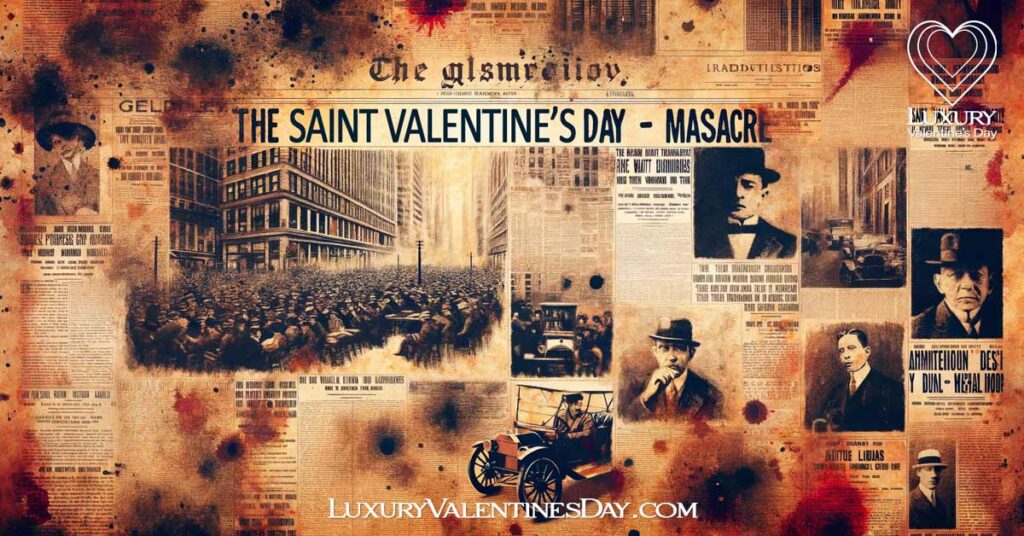
Table of Contents
ToggleThe Echoes of Gangland Chicago: Unveiling the Saint Valentine’s Day Massacre
In the heart of Chicago’s North Side, a seemingly ordinary commercial garage at 2122 North Clark Street became the stage for a chilling chapter in mob history: the Saint Valentine’s Day Massacre. On that fateful day, February 14, 1929, the violent narrative of the Roaring Twenties took a dark turn. Seven associates of George “Bugs” Moran’s bootlegging operation were mercilessly gunned down against a stark garage wall. The massacre, a brutal symbol of gang rivalry, was heavily linked to Al Capone’s infamous Chicago Outfit. Despite the notoriety of the event and the suspicions cast on Capone, the crime remained officially unsolved, with no prosecutions made.
As an experienced travel writer who has wandered these historic streets, I invite you to explore the layers beneath the Valentine’s Day Massacre. We’ll unravel the threads of prohibition, Al Capone’s notorious influence, and the event’s indelible mark on Valentine Day history. Prepare to be captivated by a narrative that goes beyond mere facts, delving into the truth about Valentine’s Day, a story that still resonates in the corridors of time.
Key Takeaways
- Pivotal Moments in History: Gain insights into the Saint Valentine’s Day Massacre and its role as a defining moment in American history.
- The Era of Prohibition: Explore how the prohibition era set the stage for one of the most infamous gangland killings.
- Al Capone’s Reign: Discover the notorious influence of Al Capone and his connection to this historic event.
- Beyond the Headlines: Delve into the real stories and the human element behind the sensationalized accounts of the massacre.
- Lasting Impact: Understand the enduring effects of the massacre on Chicago and the nation, both in public consciousness and legal landscapes.
Timeline of Key Events
| Date | Event Description | Key Figures Involved |
|---|---|---|
| Early 1920s | Al Capone moves to Chicago and joins Johnny Torrio’s gang. | Al Capone, Johnny Torrio |
| January 17, 1925 | Johnny Torrio is shot and later retires, leaving Capone as head of the Chicago Outfit. | Johnny Torrio, Al Capone |
| 1926-1928 | Escalating violence between the Chicago Outfit and the North Side Gang, including several assassination attempts and public shootouts. | Al Capone, Bugs Moran |
| February 14, 1929 | Saint Valentine’s Day Massacre: Seven members of the North Side Gang are killed. | Al Capone (alleged), Bugs Moran (target) |
| February 14, 1929 | Police arrive at the SMC Cartage Company garage to discover the aftermath of the massacre. | Chicago Police Department |
| 1930 | Public sentiment shifts significantly against gangsters, and the federal government steps up its efforts against organized crime. | General Public, U.S. Government |
| 1931 | Al Capone is tried and convicted of tax evasion. | Al Capone, U.S. Government |
| 1933 | Prohibition is repealed, marking the end of the era that saw the rise of figures like Capone. | U.S. Government |
The Roaring Twenties and Organized Crime
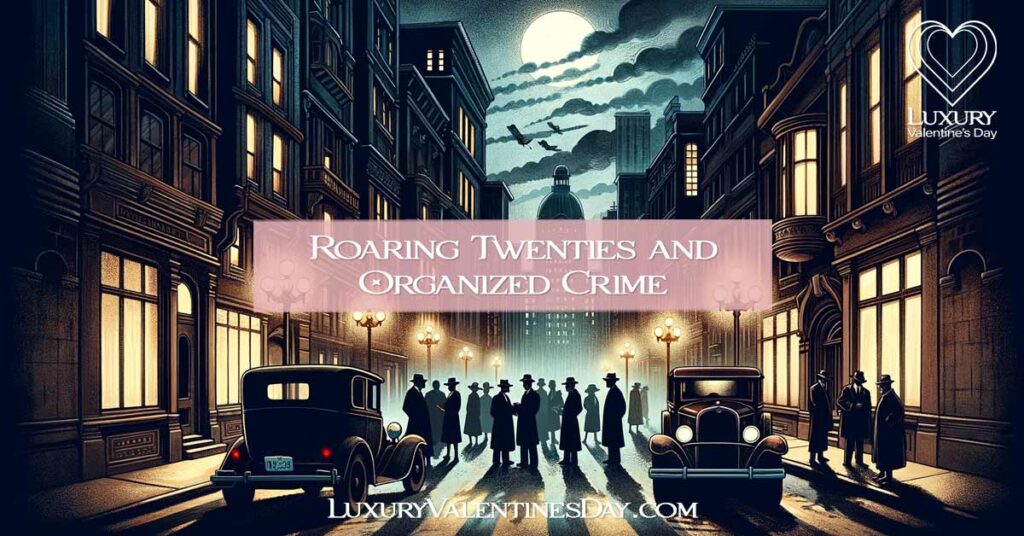
Step into the Roaring Twenties, a decade marked by jazz and jubilation, but lurking beneath its glamorous surface was a world of shadows and lawlessness. This era, characterized by the rise of organized crime, set a dramatic backdrop for what would culminate in the Saint Valentine’s Day Massacre. From speakeasies hidden behind unassuming doors to the lavish lifestyles of notorious gangsters, the 1920s painted a complex picture of American society teetering between opulence and underworld dealings.
Dive into the 1920s Era – The Rise of Organized Crime
The 1920s, often glamorized as an era of unprecedented economic prosperity and cultural revolution, had an underbelly that was far less luminous but equally transformative. It was a decade where the rapid proliferation of organized crime reshaped the American landscape, both socially and politically.
- Prohibition: The Fuel of Organized Crime: The enactment of the 18th Amendment in 1920 [1], which prohibited the manufacture, sale, and transportation of alcoholic beverages, ironically nurtured the very vice it sought to eliminate. Prohibition created a vast, unregulated black market for alcohol, offering an irresistible opportunity for criminal syndicates. These groups quickly capitalized on the public’s continued demand for liquor, leading to a booming underground economy of speakeasies and bootlegging.
- Gangsters Rise to Prominence: This illegal liquor trade laid the foundation for the rise of infamous gangsters. Figures like Al Capone (nicknamed “Scarface“) [2] in Chicago, Lucky Luciano [3] in New York, and Bugs Moran [4] became more than mere criminals; they were emperors of their illicit empires, wielding significant economic and political influence. Their operations extended beyond alcohol, encompassing gambling, prostitution, and narcotics, further entrenching their power.
- A Network of Corruption and Violence: As these criminal enterprises grew, so did their complexity and reach. Gangs formed intricate networks of corruption, often involving local politicians and law enforcement. This era saw an unprecedented level of collusion and bribery, undermining the legal system’s integrity. Violence became a common tool for maintaining control and settling disputes, with rivalries between gangs frequently escalating into public shootouts and assassinations.
- The Cultural Impact: Despite their illicit nature, these criminal activities profoundly influenced American culture. Speakeasies [5] became social hotspots, offering a blend of forbidden liquor, jazz music, and a sense of rebellion. They were more than just bars; they were symbols of defiance against the establishment. The era’s fashion, music, and slang were heavily influenced by this underworld, creating a cultural legacy that persists to this day.
- Setting the Stage for Conflict: The intense competition among criminal groups for control of the lucrative illegal markets inevitably led to conflict. Territories were fiercely contested, and alliances were as quickly made as they were broken. This volatile environment of rivalry and greed set the stage for one of the most infamous gangland massacres in American history: the Saint Valentine’s Day Massacre.
The Saint Valentine’s Day Massacre – A Detailed Look
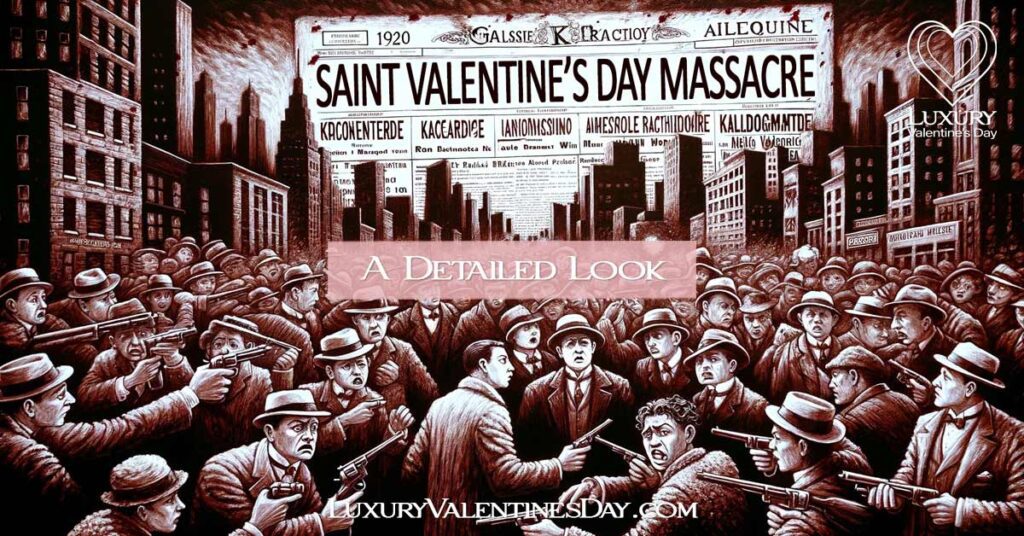
As we turn the pages back to February 14, 1929, we find ourselves amidst the grim shadows of one of the most infamous days in American criminal history: the Saint Valentine’s Day Massacre. Here, I peel back the layers of that cold winter morning, revealing the intricate details and chilling realities of the massacre. From the planning stages to the execution and the aftermath that left the nation in shock, we explore the depth of the tragedy that became a defining moment in the saga of organized crime.
Key Figures in the Saint Valentine’s Day Massacre
| Name | Role/Association | Brief Description |
|---|---|---|
| Al Capone | Chicago Outfit Leader | Alleged mastermind behind the massacre, known for his control over Chicago’s underworld. |
| George “Bugs” Moran | North Side Gang Leader | Intended target of the massacre, rival of Capone. |
| Frank Gusenberg | North Side Gang Member | Victim of the massacre, heavily involved in Moran’s operations. |
| Peter Gusenberg | North Side Gang Member | Victim of the massacre, brother of Frank Gusenberg. |
| Adam Heyer | North Side Gang Member | Victim of the massacre, key figure in Moran’s gang. |
| Reinhardt H. Schwimmer | Optometrist and Gang Affiliate | Victim of the massacre, associated with Moran’s gang. |
| Albert Kachellek (aka James Clark) | North Side Gang Member | Victim of the massacre, brother-in-law to Moran. |
| John May | Mechanic and Gang Associate | Victim of the massacre, worked for Moran’s gang. |
| Al Weinshank | North Side Gang Member | Victim of the massacre, managed several operations for Moran. |
The Prelude to Tragedy – Events Leading Up to the Massacre
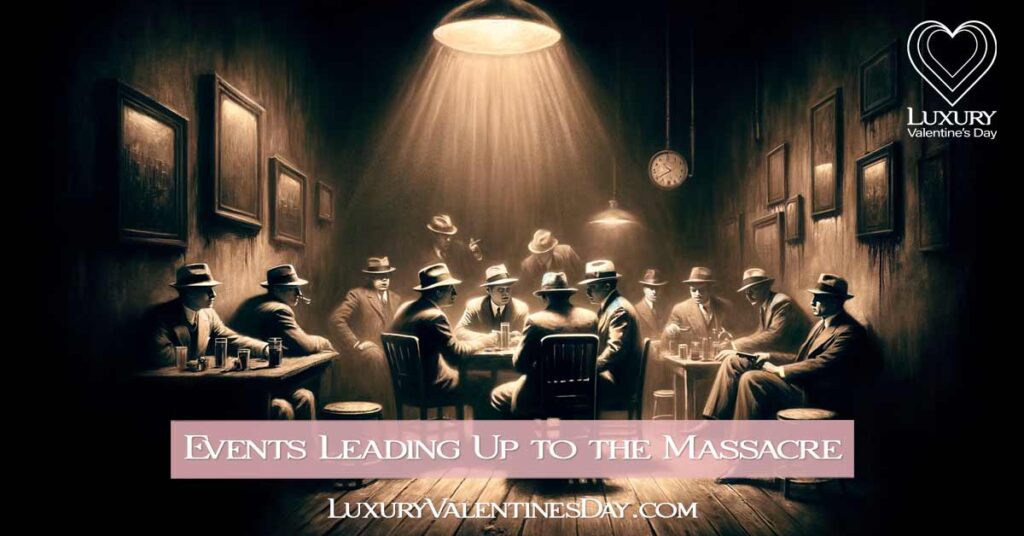
The Saint Valentine’s Day Massacre did not occur in isolation; it was the climax of a series of events fueled by rivalry, ambition, and the unquenchable thirst for power in the criminal underworld of 1920s Chicago. This subsection explores the critical moments that set the stage for one of the most brutal episodes in mob history.
- The Rise of Rival Gangs: In the 1920s, Chicago was a mosaic of competing gang territories, each vying for control over the lucrative bootlegging market. Two factions stood above the rest: Al Capone’s Chicago Outfit and George “Bugs” Moran’s North Side Gang. Their rivalry was fierce, with each side constantly seeking to undermine the other.
- A Series of Escalations: The conflict between the two gangs escalated with a series of tit-for-tat retaliations. Raids on each other’s bootlegging operations, hijackings of liquor shipments, and sporadic street violence were commonplace. This constant back-and-forth bred a deep-seated enmity, setting a volatile backdrop for the massacre.
- The Plan to Eliminate Moran: Al Capone, seeking to consolidate his control over the Chicago underworld and eliminate his arch-rival, allegedly devised a plan to kill George “Bugs” Moran. The plan was to lure Moran and his top lieutenants to a garage on North Clark Street under the guise of a lucrative bootlegging deal.
- The Deceptive Setup: A stolen truck, loaded with what was purported to be a shipment of stolen, high-quality whiskey, was the bait. The word was discreetly spread to Moran’s gang that this shipment would be available for purchase at an exceptionally low price, a deal too good to pass up.
- The Morning of February 14, 1929: On the morning of the massacre, the stage was set. Moran’s gang members, lured by the promise of cheap whiskey, gathered at the SMC Cartage Company garage on 2122 North Clark Street, Chicago. Unbeknownst to them, a deadly trap had been laid.
The Day of Infamy – The Saint Valentine’s Day Massacre Unfolds
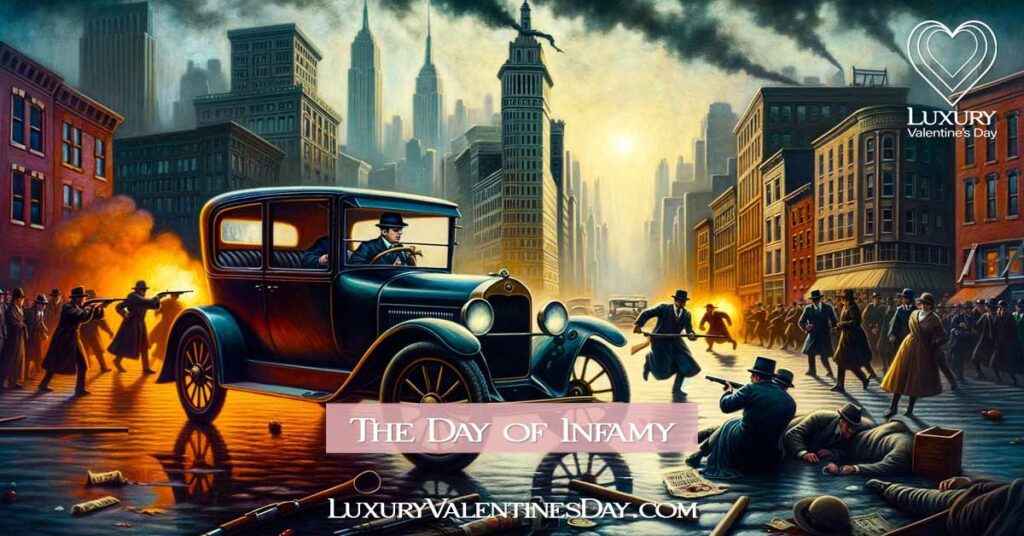
The Saint Valentine’s Day Massacre stands as a stark embodiment of the brutality and ruthlessness of gangland warfare in Prohibition-era Chicago. This part of the story delves into the harrowing details of the massacre, the key players involved, and the immediate aftermath that shook the city and the nation.
- The Execution of the Plan: On the morning of February 14, 1929, as members of Moran’s gang congregated at the SMC Cartage Company garage, their fate was already sealed. Witnesses later reported seeing a police car pull up to the garage, an ominous sign in an era when corrupt police involvement with gangs was not uncommon.
- The Attackers and Their Disguise: Four men exited the vehicle – two dressed as police officers and two in plain clothes. The police uniforms were part of the plan to confuse and disarm Moran’s men, creating an illusion of a routine raid. This ruse was intended to prevent resistance and ensure the execution of the plan without interference.
- The Brutal Shooting: The men, believed to be members of Capone’s gang, lined up the seven individuals inside the garage against the wall. What followed was a merciless barrage of gunfire. Using Tommy guns [6] and shotguns, the attackers unleashed a volley of bullets, leaving no chance of survival for those caught in the hail.
- The Victims: The brutality of the attack claimed the lives of seven individuals: Frank Gusenberg, Pete Gusenberg, James Clark, Adam Heyer, Al Weinshank, and John May – all members or associates of Moran’s gang. Also caught in the deadly crossfire was a visitor, Dr. Reinhardt H. Schwimmer, who found himself at the wrong place at the wrong time. George “Bugs” Moran, the intended target, narrowly missed the massacre, arriving moments too late to meet the same fate as his associates.
- The Immediate Aftermath: Following the shooting, the attackers, still in their police disguises, exited the garage, feigning the arrest of the two plainclothes men. This act furthered the illusion of a police raid, delaying the discovery of the massacre. By the time the bodies were found, the killers were long gone. The grisly scene inside the garage quickly drew public attention, with images of the bloodbath making national headlines.
- The Shockwave Through Chicago and Beyond: The massacre sent shockwaves through Chicago and across the nation. It marked a turning point in public perception of gang violence, highlighting the sheer brutality and lawlessness of the era. The failure to bring the perpetrators to justice only added to the outrage and underscored the deep-rooted corruption and impotence of law enforcement against organized crime.
The Aftermath and the Elusive Justice – Investigating the Massacre
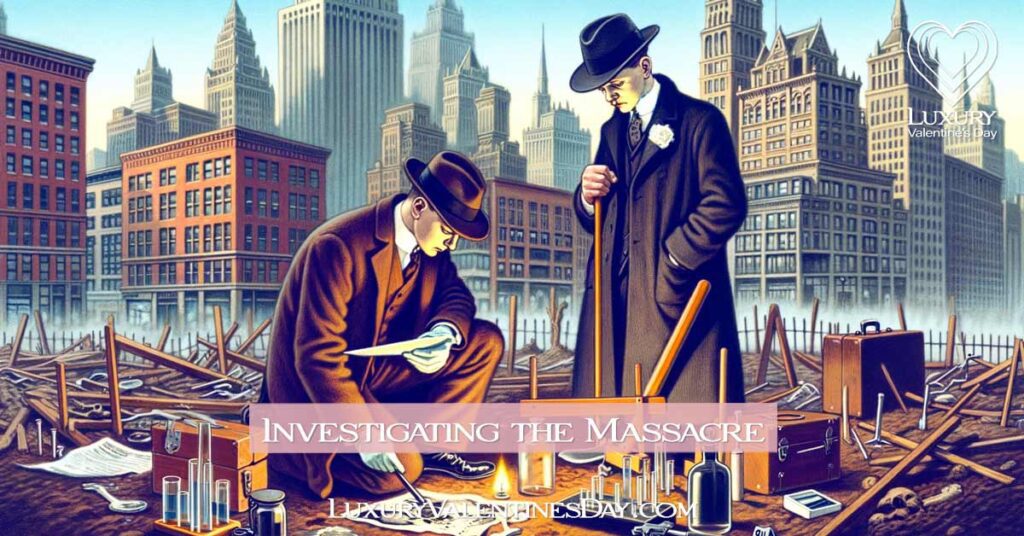
The Saint Valentine’s Day Massacre, while marking a brutal moment in criminal history, also highlighted the significant challenges law enforcement faced in combating organized crime during the Prohibition era. This subsection examines the investigation that followed the massacre and the obstacles that impeded justice.
- Launching the Investigation: In the aftermath of the massacre, Chicago police launched what would become one of the most high-profile investigations of the era. The public outcry over the bloodshed and the failure to prevent such an event put immense pressure on law enforcement to find and prosecute those responsible.
- Al Capone: The Prime Suspect: Suspicion quickly fell on Al Capone as the mastermind behind the massacre, largely due to his known rivalry with George “Bugs” Moran and his quest for dominance in the Chicago underworld. However, Capone, who was in Florida at the time of the massacre, maintained a strong alibi.
- Challenges in Gathering Evidence: The investigation was hampered by a lack of cooperative witnesses and tangible evidence. The code of silence prevalent in the criminal underworld, combined with the public’s fear of retribution, meant that few were willing to come forward with information. Additionally, the sophistication of the crime and the cleanup efforts by the perpetrators left little for investigators to work with.
- Corruption and Infiltration: Another significant challenge was the widespread corruption within the police force and other city institutions. Organized crime had deeply infiltrated these bodies, making it difficult to conduct an unbiased and effective investigation. There were suspicions that some law enforcement officials may have been complicit in the massacre or deliberately impeded the investigation.
- The Role of the Media: The intense media coverage of the massacre and the subsequent investigation played a dual role. While it helped keep public attention on the case, it also led to sensationalism and misinformation, complicating the investigative process and adding pressure on law enforcement to deliver quick results.
- The End Result: Despite extensive efforts, the investigation into the Saint Valentine’s Day Massacre failed to conclusively solve the case. No one was ever prosecuted for the murders, and the massacre remained one of the most infamous unsolved crimes in American history. This failure further entrenched the public’s perception of the era’s rampant lawlessness and the impotence of law enforcement against the powerful forces of organized crime.
Al Capone – The Man Behind the Myth
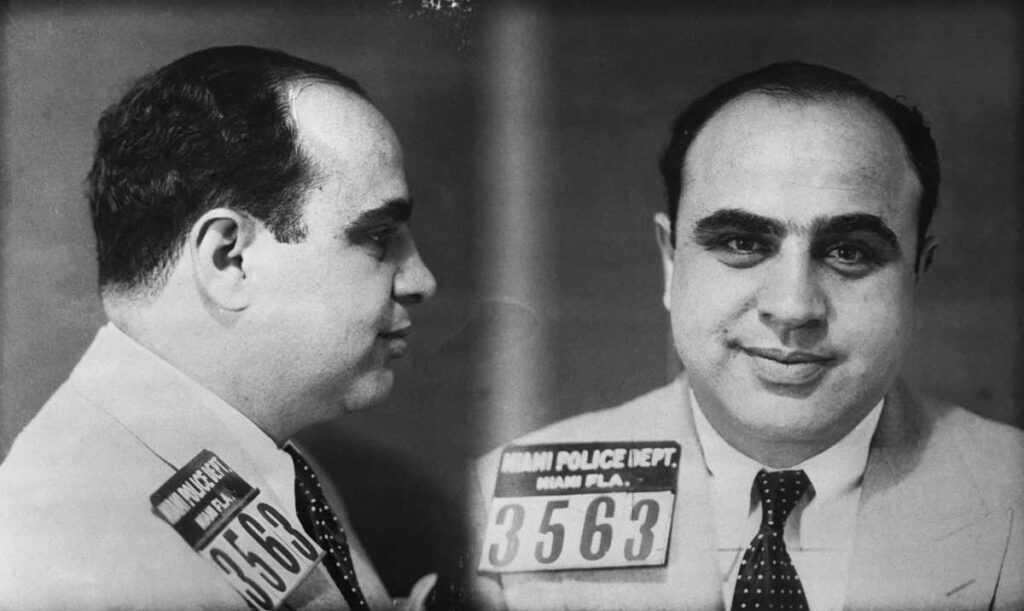
Al Capone in Miami, Florida, May 6, 1930. Public Domain. Image source.
Here, we delve into the enigmatic figure at the heart of the Saint Valentine’s Day Massacre narrative: Al Capone. Beyond the notorious gangster image lies a complex character whose life story intertwines with the fabric of American history. We’ll explore Capone’s journey from a Brooklyn street tough to the undisputed kingpin of Chicago’s underworld, unraveling the layers of myth to reveal the man behind the legend. From his early days to his ultimate downfall, this section aims to provide a nuanced understanding of one of the most infamous figures of the 20th century.
The Making of a Mobster – Al Capone’s Early Years
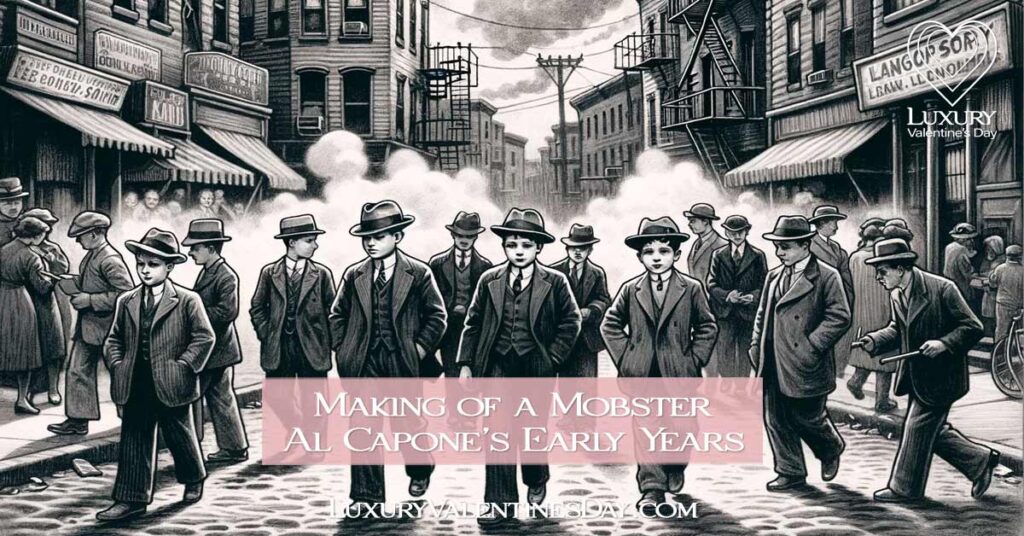
Al Capone’s journey to becoming one of the most notorious gangsters in American history began far from the glitz and glamour of the criminal empire he would eventually lead. This subsection delves into his early life, providing insights into the experiences and influences that shaped his ascent in the criminal underworld.
A Humble Beginning in Brooklyn
Born on January 17, 1899, in Brooklyn, New York, to Italian immigrant parents, Alphonse Gabriel Capone grew up in a modest, working-class neighborhood. His upbringing in the teeming, diverse streets of Brooklyn provided a backdrop for his early exposure to the realities of street life and petty crime.
Education and Early Influences
Capone’s formal education was short-lived; he dropped out of school after the sixth grade. During his time in school, he showed promise but was more drawn to the street life that surrounded him. It was during these formative years that he became involved with local gangs, notably the Five Points Gang [7], which included future organized crime figures.
The Move to Chicago
The turning point in Capone’s criminal career came with his move to Chicago in the early 1920s. He initially worked for Giovanni “Johnny” Torrio [8], a leading figure in the city’s underworld. Torrio’s mentoring and the chaotic, lawless landscape of Prohibition-era Chicago provided the perfect training ground for Capone’s criminal ambitions.
Rapid Ascent in the Criminal Hierarchy:
Capone quickly rose through the ranks due to his intelligence, charisma, and ruthlessness. Following Torrio’s retirement after an assassination attempt, Capone took over the operations, transforming what was a powerful local gang into a national criminal empire. His business acumen, combined with his willingness to use violence, made him an influential and feared figure in the underworld.
The Birth of ‘Public Enemy Number One’
Capone’s rise coincided with increasing public scrutiny of gang activities, especially in the wake of events like the Saint Valentine’s Day Massacre. He became a symbol of the era’s lawlessness, earning the moniker “Public Enemy Number One.” Despite his criminal activities, Capone cultivated a Robin Hood-like image, often engaging in charitable acts to bolster his public persona.
The Infamous Act and the Fall from Grace – Capone’s Ties to the Massacre and Legal Downfall

In this part I’ll delve into Al Capone’s alleged involvement in the Saint Valentine’s Day Massacre and the cascade of legal troubles that followed, marking the beginning of the end of his reign over Chicago’s underworld.
Alleged Mastermind Behind the Massacre
While Al Capone was never formally charged with the Saint Valentine’s Day Massacre, he was widely suspected of orchestrating it. The massacre was seen as a bold move to eliminate his rivals and consolidate his power in the city. Capone’s well-known rivalry with George “Bugs” Moran, the intended target of the massacre, further fueled these suspicions.
The Florida Alibi
At the time of the massacre, Capone had conveniently positioned himself in Florida, a strategic move that provided him with a solid alibi. Despite the lack of physical presence, investigators and the public alike believed that Capone had ordered the hit from afar, employing his network to carry out the brutal plan.
Increased Federal Attention
The massacre escalated Capone’s notoriety and drew increased attention from federal authorities. The government, under immense public pressure to curb gangland violence and corruption, intensified its efforts to bring down Capone and his criminal empire.
The Tax Evasion Case
The breakthrough in Capone’s legal troubles came not from his numerous violent crimes but from tax evasion. In a strategic move, federal authorities, led by Eliot Ness [9] and his team of “Untouchables,” focused on Capone’s financial activities. They meticulously traced his income and expenditures, uncovering a substantial amount of unreported income.
The Trial and Conviction
In 1931, Capone was brought to trial on charges of tax evasion. The prosecution’s case, bolstered by thorough documentation and witness testimonies, proved too substantial for Capone’s defense to counter. He was found guilty and sentenced to 11 years in prison, marking a significant victory for law enforcement and a symbolic end to the era of unchecked organized crime.
The Imprisonment and Decline
Capone’s incarceration, first in Atlanta U.S. Penitentiary and later in the infamous Alcatraz, marked the decline of his influence and health. His time in prison was plagued by declining health, exacerbated by syphilis, which he had contracted in his youth. The once-feared gangster’s power and health steadily waned until his release in 1939, after which he lived a quiet life until his death in 1947.
Al Capone’s Notable Activities

- Joining the Five Points Gang in New York: Capone’s early involvement with one of the most powerful gangs in New York laid the foundation for his criminal career.
- Moving to Chicago and Joining Johnny Torrio’s Gang: This move marked Capone’s entry into the Chicago underworld.
- Rising to Lead the Chicago Outfit: After Johnny Torrio’s retirement, Capone took control, significantly expanding the gang’s operations.
- Involvement in the Bootlegging Business During Prohibition: Capone’s bootlegging operations under Prohibition were a major source of his power and wealth.
- The Saint Valentine’s Day Massacre: Though never proven, Capone is widely believed to have orchestrated the massacre to eliminate rival gang members.
- Conviction for Tax Evasion: In a landmark case, Capone was convicted of tax evasion in 1931, leading to his imprisonment.
- Philanthropic Acts: Despite his criminal activities, Capone was known for his charitable acts, which contributed to his complex public image.
- Imprisonment and Decline in Health: His time in prison marked the end of his criminal reign and saw a significant decline in his health.
The Lasting Echo – Capone’s Enduring Legacy in Culture and History
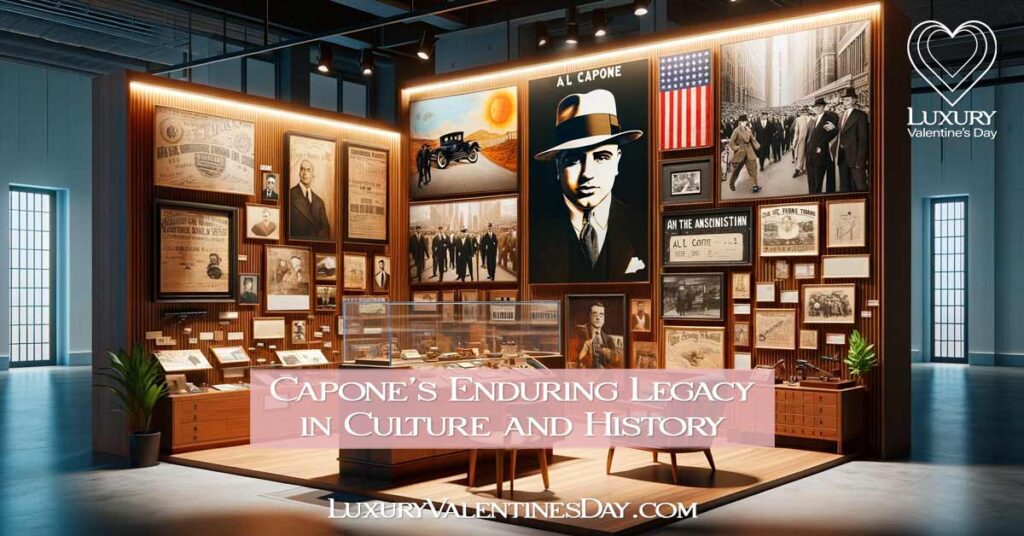
Al Capone’s influence extends far beyond his lifetime and criminal activities, embedding itself into the fabric of popular culture and historical discourse. This subsection explores the multifaceted legacy of Capone, examining how he has been remembered, portrayed, and analyzed in the years following his death.
The Gangster Archetype
Capone’s life and persona have come to define the archetypal American gangster. His blend of charm, brutality, and business acumen has been immortalized in numerous movies, books, and television shows. Characters inspired by Capone often embody the complexities of the criminal mind, blurring the lines between villain and anti-hero.
Media and Entertainment
From classic films like “The Untouchables” to more recent portrayals in series like “Boardwalk Empire,” Capone’s character has been a fixture in entertainment media. These portrayals often emphasize his dual nature as both a ruthless crime lord and a charismatic public figure. His story has captivated audiences, reflecting society’s fascination with the darker aspects of human nature and history.
Historical Analysis and Debate
Capone’s impact on American history has been a subject of extensive analysis and debate among historians. His rise and fall are often studied in the context of Prohibition, organized crime, and law enforcement in the early 20th century. Discussions about Capone also delve into broader themes such as the American Dream, corruption, and the role of government in enforcing morality.
Tourism and Folklore
In Chicago and beyond, Capone has become a part of local folklore. Tours highlighting his hangouts, the sites of infamous events like the Valentine’s Day Massacre, and his eventual prison, Alcatraz, attract numerous visitors each year. These sites serve as tangible connections to a bygone era, allowing people to explore a pivotal chapter in American history.
Influence on Crime and Law Enforcement
Capone’s legacy is also evident in the evolution of organized crime and law enforcement. His methods and the government’s response to his activities have influenced how law enforcement agencies tackle organized crime. The focus on financial crimes, like tax evasion, has become a key strategy in prosecuting high-profile criminal figures.
Capone in the Public Imagination
Decades after his death, Capone remains a figure of public fascination. His life story continues to be the subject of various documentaries and biographical works, each offering new perspectives on his life and times. Capone’s enduring presence in popular culture and historical narratives underscores his complex role as both a notorious criminal and a symbol of a transformative period in American history.
Cultural Representations of the Massacre
- Movies: “The St. Valentine’s Day Massacre” (1967), “Some Like It Hot” (1959) – loosely based on the event, “Capone” (1975).
- Television Shows: Episodes in “The Untouchables” (1959-1963), “Boardwalk Empire” (2010-2014) – features characters and events inspired by the era.
- Books: “Get Capone” by Jonathan Eig, “Capone: The Man and the Era” by Laurence Bergreen.
- Documentaries: “The Real Story: The Untouchables” (2011), “Al Capone: Icon” (2014).
- Theatre: The play “Valentine’s Day” (1992), which explores the events leading up to the massacre.
- Music: Various songs reference Capone and the Prohibition era, encapsulating the cultural impact of the event.
Impact and Legacy

In the final part of our journey through the dark alleys of the Roaring Twenties and the aftermath of the Saint Valentine’s Day Massacre, we turn our attention to the broader implications of these events. This section delves into the lasting impact of the massacre and the era of organized crime on American society, law enforcement, and cultural consciousness. We’ll explore how this tumultuous period not only reshaped the legal and social landscape but also left an indelible mark on the collective memory, continuing to influence contemporary perspectives on crime, justice, and the American identity.
Echoes Through Time – The Massacre’s Impact on Society and Law Enforcement
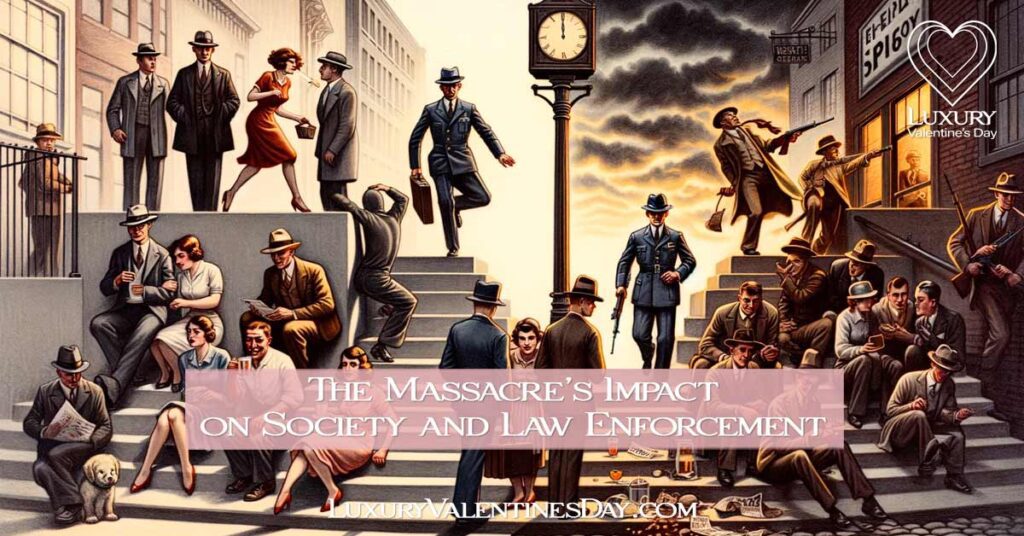
The Saint Valentine’s Day Massacre was more than a shocking episode of violence; it was a catalyst that triggered profound changes in American society and the approach to law enforcement. This subsection examines the far-reaching consequences of this event.
- A Turning Point in Public Perception: The massacre marked a significant shift in how the public perceived organized crime. The brutality and brazen nature of the attack, coupled with the media’s sensational coverage, shattered any romanticized notions of gangsters as mere mischief-makers. It laid bare the true dangers and moral decay associated with the criminal underworld, sparking a nationwide outcry for action against such lawlessness.
- Strengthening Law Enforcement Response: In response to the growing public demand for safety and order, law enforcement agencies began to intensify their efforts against organized crime. The massacre underscored the need for better-equipped, more sophisticated police forces capable of tackling the increasingly complex and well-organized criminal networks. It also highlighted the importance of federal involvement in combating crimes that crossed state lines.
- Legislative Changes and Prohibition’s End: The public outcry following the massacre contributed to the growing skepticism about the effectiveness of Prohibition. Many began to question whether the ban on alcohol was fueling the very criminal activities it aimed to curb. This shift in public opinion played a significant role in the eventual repeal of the 18th Amendment in 1933 [10], ending Prohibition and closing a chapter that had inadvertently given rise to widespread organized crime.
- Advancements in Criminal Forensics and Investigation Techniques: The complexities of the massacre investigation revealed the limitations of existing police methods and spurred advancements in criminal forensics and investigative techniques. The need for more scientific and methodical approaches to crime scene investigation, evidence gathering, and analysis became evident, leading to significant progress in these areas.
- Influencing the Federal Crime-Fighting Agenda: The massacre and the era’s rampant gang violence prompted the federal government to take a more active role in crime-fighting. This period saw the emergence and strengthening of federal agencies like the Federal Bureau of Investigation (FBI), setting the stage for more coordinated and effective responses to organized crime at a national level.
- Cultural Shifts and Awareness: Beyond the legal and law enforcement realms, the massacre had a lasting cultural impact. It became a symbol of the era’s excesses and the dark side of the American Dream. The event and its aftermath have been deeply ingrained in American culture, serving as a cautionary tale about unchecked ambition and the perils of societal complacency towards crime.
Enduring Shifts – Long-Term Impact on Public Perception and Law Enforcement Evolution
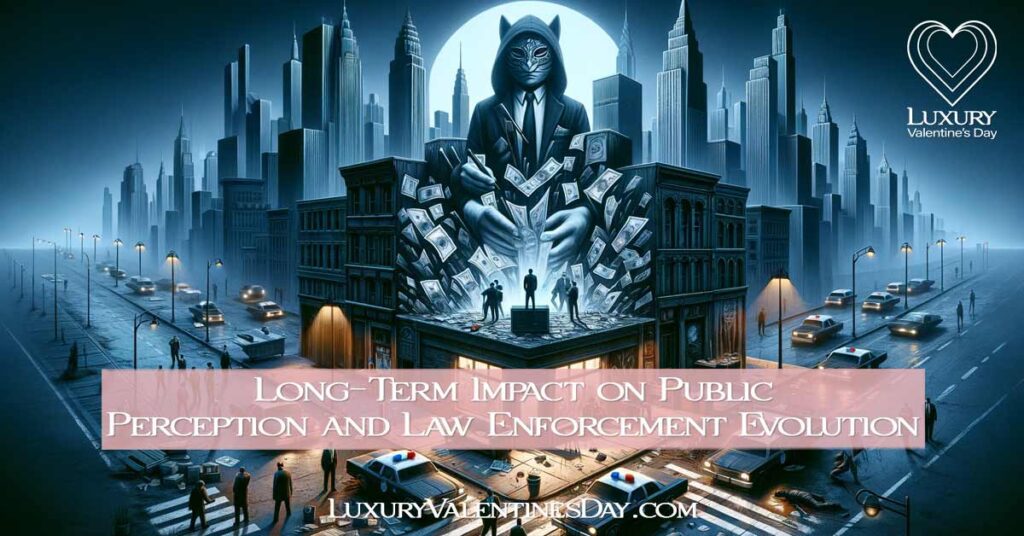
This subsection examines the lasting changes in public perception of organized crime and the enduring evolution in law enforcement strategies that emerged in the wake of the Saint Valentine’s Day Massacre.
- Long-Term Public Perception Changes: While the immediate aftermath of the massacre saw a shift in public opinion, its long-term effects have been more profound. The romanticized image of gangsters has been largely replaced by a more realistic and often negative portrayal, influenced by the understanding of the true violence and societal damage caused by organized crime. This shift has been sustained in public consciousness, affecting attitudes towards crime and justice in American society.
- Evolution of Law Enforcement Strategies: The immediate response to the massacre was an increase in resources and a change in tactics. Over time, this has evolved into a more sophisticated approach to combating organized crime. Techniques developed initially in response to events like the massacre, such as forensic accounting and coordinated inter-agency operations, have become standard practice in modern law enforcement.
- Influence on Federal and Local Policing Policies: The massacre underscored the need for federal involvement in what were often interstate criminal activities. Over the decades, this has led to a more collaborative relationship between local and federal law enforcement agencies. The role of the FBI and other federal agencies has expanded, with a greater emphasis on organized crime, leading to more effective nationwide crime-fighting strategies.
- Cultural and Educational Impact: The lasting impact of the massacre has also been seen in the fields of education and culture. It has become a case study in criminal justice and law enforcement courses, shaping new generations of law enforcement professionals. In popular culture, the narrative surrounding gangsters and organized crime has matured, often focusing on the moral and ethical dilemmas associated with crime and law enforcement.
- Ongoing Public Dialogue and Media Representation: The narrative around the massacre and its characters, like Al Capone, continues to evolve in media and public discourse. This ongoing dialogue reflects and influences societal views on crime, punishment, and justice. The evolution of this narrative demonstrates the massacre’s role in shaping a more nuanced and critical public understanding of organized crime and its implications.
Conclusion

As we reflect on the Saint Valentine’s Day Massacre and its reverberations through the annals of history, it becomes clear that this event was more than a mere moment of violence; it was a turning point that reshaped American society in profound ways. The massacre, set against the backdrop of the Roaring Twenties and the Prohibition era, offers a stark reminder of the complexities and contradictions of that time.
- A Catalyst for Change: The Saint Valentine’s Day Massacre served as a catalyst that transformed public opinion about organized crime and prompted significant changes in law enforcement strategies. It marked the end of an era where gangsters like Al Capone could operate with near impunity, leading to a more vigilant and sophisticated approach to combating organized crime.
- Al Capone’s Legacy: Al Capone, a central figure in this narrative, remains a symbol of the era’s excesses and its dark underbelly. His rise and fall illustrate the potential and perils of the American Dream, as well as the thin line between legend and infamy. Capone’s story continues to fascinate and serve as a cautionary tale about power, corruption, and the consequences of unchecked ambition.
- Enduring Influence on Culture and Law Enforcement: The massacre’s influence extends beyond its immediate aftermath, affecting cultural expressions, law enforcement techniques, and public policy. Its legacy is evident in the modern approaches to crime fighting, the ongoing public discourse on justice and morality, and the persistent cultural fascination with the Prohibition era and its notorious personalities.
- Reflections on Justice and Morality: The events surrounding the massacre and the figures involved prompt broader reflections on themes of justice, morality, and the role of government. They challenge us to consider how societal values and norms influence, and are influenced by, the actions of individuals and institutions.
The Saint Valentine’s Day Massacre stands as a poignant reminder of a tumultuous period in American history. It encapsulates the complexities of the Prohibition era, the dangers of organized crime, and the societal shifts that occurred in its wake. Its story, woven into the fabric of American history, continues to resonate and inform our understanding of crime, justice, and the ongoing pursuit of a more orderly and just society.
FAQ Section: The Saint Valentine’s Day Massacre
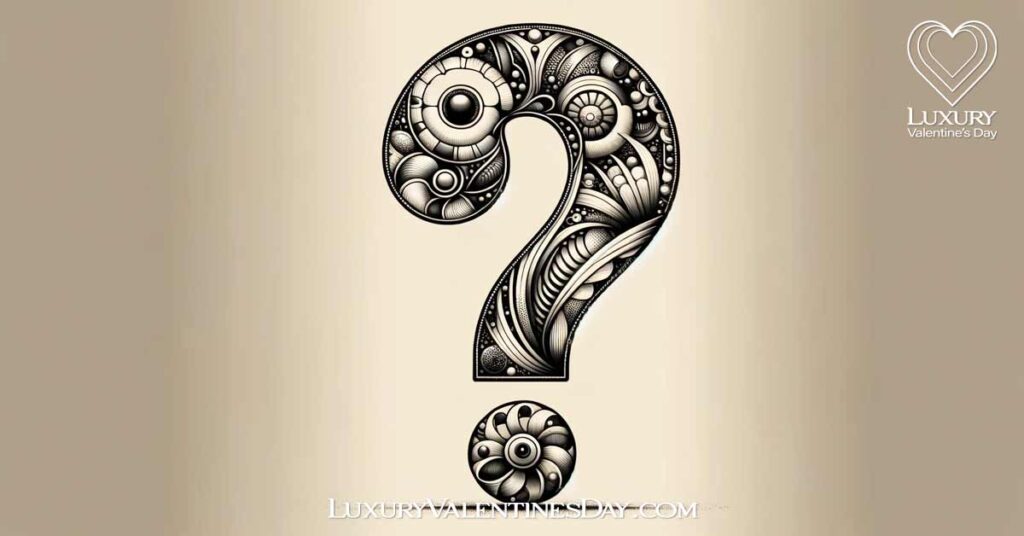
Who died at the St Valentine’s Day Massacre?
The victims of the St Valentine’s Day Massacre were seven men associated with George “Bugs” Moran’s North Side Gang. They were Frank and Peter Gusenberg, James Clark (Albert Kachellek), Adam Heyer, Reinhardt Schwimmer, Albert Weinshank, and John May.
Who was John May in the Saint Valentine’s Day Massacre?
John May was a mechanic who worked for the North Side Gang. He was not a gangster but was affiliated with them due to his work. May was repairing a car in the garage on the day of the massacre and became one of the victims.
What are some facts about the St Valentine’s Day Massacre?
- Date: February 14, 1929.
- Location: SMC Cartage Company garage, 2122 North Clark Street, Chicago.
- Seven men were killed in the massacre.
- The massacre was linked to Al Capone’s gang, though no one was convicted.
- The main target, George “Bugs” Moran, escaped as he arrived late.
Where did the Saint Valentine’s Day massacre take place?
The Saint Valentine’s Day massacre occurred at the SMC Cartage Company garage located at 2122 North Clark Street in Chicago.
What happened to the dog from St Valentines Massacre?
The dog, a German Shepherd named Highball, belonged to the mechanic John May. It was found alive and unharmed in the garage after the massacre. The dog’s distressed howls reportedly alerted neighbors, leading to the discovery of the massacre.
How did the St Valentine’s Day Massacre change forensic science?
The St Valentine’s Day Massacre highlighted the limitations of forensic science and investigative techniques of the time. It led to advancements in ballistics, with forensic scientists beginning to use more sophisticated methods to match bullets to guns. The case also underscored the importance of crime scene preservation and the systematic collection of evidence. These changes helped lay the groundwork for modern forensic science.
References
[1] Enactment of the 18th Amendment in 1920 by Lisa Andersen on Gilder Lehrman website. http://ap.gilderlehrman.org/history-by-era/roaring-twenties/essays/prohibition-and-its-effects
[2] Al Capone, from the Federal Bureau of Investigation’s (FBI) official website https://www.fbi.gov/history/famous-cases/al-capone
[3] Lucky Luciano, from The National Museum of Organised Crime & Law Enforcement – The Mob Museum https://themobmuseum.org/notable_names/lucky-luciano/
[4] Bugs Moran by Marilyn Bardsley for the “Crime Library : Criminal Minds and Methods” https://www.crimelibrary.org/gangsters_outlaws/mob_bosses/capone/bugs_11.html
[5] Speakeasies by Anna Kaufman for “USA Today Life” https://eu.usatoday.com/story/life/2022/08/16/what-is-a-speakeasy/10302088002/
[6] The Tommy gun by Arnold Blumberg for the Warfare History Network. https://warfarehistorynetwork.com/thompson-guns-curious-history-from-world-war-i-to-world-war-ii/
[7] The Five Points Gang https://www.famousfix.com/list/five-points-gang
[8] Giovanni “Johnny” Torrio https://www.legendsofamerica.com/johnny-torrio/
[9] Eliot Ness by Rebecca McFarland for the Cleveland Police Museum. https://www.clevelandpolicemuseum.org/collections/eliot-ness/
[10] Repeal of the 18th Amendment in 1933 by Nicholas J. Dilley, Ronald Reagan Presidential Library & Museum. https://www.reaganlibrary.gov/constitutional-amendments-amendment-21-repeal-prohibition
Related Posts
- Date Ideas That Start with G: Great and Grand Dates
- Ombre Decorated Cookies: Tips for Stunning Gradient Designs
- Date Ideas That Start with W: Wonderful and Whimsical Dates
- Date Ideas That Start with Z: Zany and Zesty Dates
- 50 Valentine’s Day Hanging Decor Ideas: Transform Your Space with Romantic Touches
- Date Ideas That Start with H: Happy and Heartfelt Dates














